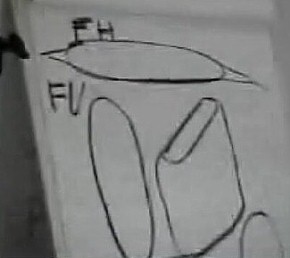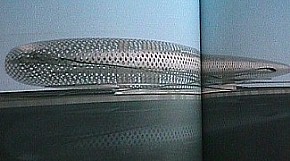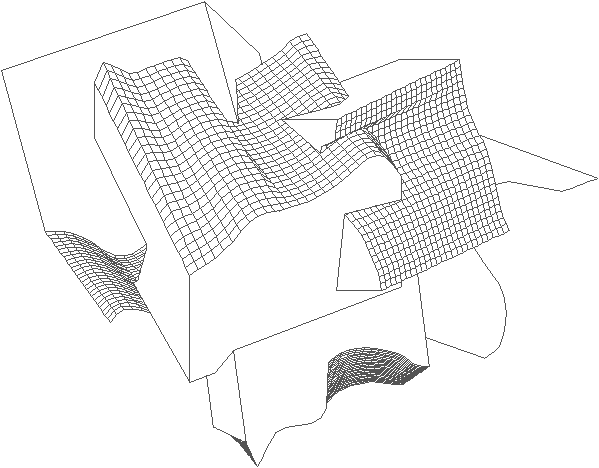2008.12.23 20:29
pragmatists turning political?
I'm using "reenactionary" more in terms of how ZP's designs 'reenact' the mat/box/blob paradigm of Le Corbusier's Electronic Calculation Center Olivetti at Rho-Milan. Although intrigued by ZP's 'new politics of the envelope' I'm not sure 'politics' is the right word to describe what it's really about, but it might just be right.
ZP notes how in the past it was in the plan where 'politics' was found, whereas he now see the politics in the envelope, and there seems to be something to that. Just recently I looked closely at the plan of the Palace of Versailles (when I was also reading ZP's essay in Log), and besides the political implication of the King's Bedroom on axis in the center, the similarity in plan of the Chapel and the Opera off to the side respectively got me thinking not just of their relative marginal positions, but how both plans represent 'theaters'. Anyway, if ZP's politics of the envelope can operate/communicate in the same type of way, it seems that would make for a novel/fecund design methodology.
2008.12.24 10:29
pragmatists turning political?
"Instead of a revolutionary architecture, an architecture of explicitation would imply more complex political directionalities as it transforms the space and the material organization of the built environment, even if those transformations cannot be inscribed in a holistic political program. For architecture to express the domestication of density and high-rise life through specific massing strategies in tall buildings, to convey that tendencies in the articulation of the building envelope capture the new political affects, to communicate that certain manipulations of the ground and the roof indicate the politicization of nature, or to explain the breakdown of the correlation between interior and exterior and private and public, are legitimate political performances."
--AZP
That is what I assume to be the gist of the so-called general theory of the building envelope as expressed within 'The Political Agency of Dimension' within "The Politics of the Envelope".
Because I see all this relating to Le Corbusier's late Olivetti project first, I looked again at UN Studio's Intramural Centre (project, 1994) as presented within the "Effects" book of MOVE (1999), since this project too reenacts the Le Corbusier paradigm. And then, as I looked through the rest of MOVE, I began to see that the 'envelope' was already often taken into a kind of 4th dimension, a kind of hyper-envelope. Somewhat ironically, UN Studio's proposal for the Yokohama Port Terminal already portends what AZP is now espousing.
2008.12.25 19:05
pragmatists turning political?
When AZP writes "or to explain the breakdown of the correlation between interior and exterior and private and public, are legitimate poltical performances," it only seems fair to include UN Studio's work.
I mentioned UN Studio's Yokohama terminal project because "the organizing principle of the terminal is the structural association of architecture to infrastructure and landscape; garden-like voids are absorbed into the architecture and then proceed to transform it" and one of the section drawings calls out a 'climatic facade system'. Further reading reveals some strangeness, however. "This design-by-section represents one of our first, incomplete, experiments with 4-D architecture. The building itself was never designed, but 30 sections were worked out, after which 3-D Studio was used to fill in what was left." "Finally a photo-shopped skin was wrapped around the resulting composition in order to simulate the appearance of a building." Politics of the envelope indeed?
from Webster's Third International Dictionary:
politics 1 a : the art or science of government : a science dealing with the regulation and control of men living in society (as nations or states) in both internal and external affairs : the art of adjusting and ordering relationships between individuals and groups in a political community
Electronic Calculation Center Olivetti at Rho-Milan
The huge development is divided into three construction stages:
First stage: main entrance with restaurants, library and other social facilities, then the first sguare workshop block measuring 350 ft. x 350 ft. Above this block are ten storeys of research laboratories.
The assembly shops are at ground level. The entrances, however, are located at roof level. By means of an entrance ramp the employees reach the connecting corridors which lead to the three [amoebae]-shaped locker and washroom blocks. One enters the various shops at ground level by means of stairways.
The workrooms receive well-distributed daylight from above; there is also a plantation on the roof and a sprinkler system which provides cooling during hot weather.
Again AZP: "...certain manipulations of the ground and the roof indicate the politicization of nature."
| |
2008.12.26 12:37
pragmatists turning political?

AZP from the Berlage lecture
top: flat horizontal, permeable, social mobility, handling flows, movement

UN Studio, Yokohama Port Terminal, 1994
I'm wondering whether a hyper-envelope can deliver a hyper-politicization.
some coincidental reading from earlier this morning...
"Vico's own approach to this new science was by way of a new theory of knowledge. The first clear trace of this appears in his inaugural oration of 1708 comparing ancient and modern methods of study. The moderns have instituted great improvements in the physical sciences, but have unduly depreciated those studies whose matter depends on the human will and therefore involves vicissitude and probability--languages, poetry, eloquence, history, jurisprudence, politics."
AZP's language does slide easily (to other projects), and that is because much of it is at base a typological analysis.
AZP's language also slides easily from (historical) formal analysis to prescriptive methodology.
2008.12.30 09:00
pragmatists turning political?
context/inspiration
Pier Vittorio Aureli's "Toward the Archipelago: Defining the Political and the Formal in Architecture" (in Log 11, Winter 2008) lays out the context of Alejandro Zaera-Polo's "The Politics of the Envelope" (in Log 13/14, Fall 2008).
within Toward the Archipelago:
Urbs vs. Civitas
Urbanization
Infinity and Enclaves of Urbanization
The Enclave and the Landmark
The Political
The Formal
The Archipelago
Architecture
passages from The Political:
"Politics arises between men, and it is established as a relationship." (Arendt)
The space in-between can only materialize as a space of confrontation between parts. Its existence can only be decided by the parts that form its edges.
In the dual terms of Carl Schmitt, the space in-between is formed by the decision of who is a friend and who is an enemy. This decision does not exist "as found" in between the parts, but arises from the position taken by the parts that form this space.
...the notion of agonism--the counterpositing of parts--functions as a critical mirroring of oneself via the other to the extent that it is possible to say that to make a collective claim of political autonomy, one must first declare one's counterpoint.
The enemy, on the other hand, estranges us from our familiar self-perception and gives us back the sharp contour of our own figure, of our own position. What counters us inevitably constitutes the knowledge of our own limit.
The political cannot be reduced to conflict per se; it indicates the possibility of conflict and as such calls for its resolution. Even if it means slightly confounding the terms of Hegel's dialectic, the political realizes the resolution of conflict not by a synthesis of confronting parts, but by recognizing the opposition as a composition of parts. This suggests that it is possible to theorize a phenomenological and symbolic coincidence between political action and the form of an object.
[This is the space of the politics of the envelope.]
Both deal with the fundamental question of defining the limits that constitute related but different parts. From this vantage point--the question of a composition of parts, the question of limits posed through the knowledge of the other--I propose to redefine the concept of the formal.
aggregate base
| |
2008.12.31 09:38
pragmatists turning political?
The concluding 'Architecture' section of Aureli's "Toward the Archipelago" begins with:
"Let's immediately state that today's iconic building--the building that affirms its own singular presence through the appearance of its image, and that today constitutes one of the primary expressions of architectural culture at the scale of the city--cannot be a valid part of the city. Putting aside moral problems, issues of taste, and the gratuitous character of their forms, the iconic building cannot be considered an exemplary part of the city because its economic principle is to be unique and nonrepeatable."
This may well be what spurred Zaera-Polo's "The Politics of the Envelope".
[What works for me is...] Mixing Aureli's "The political ... indicates the possibility of conflict and as such calls for its resolution" and Zaera-Polo's "For architecture ... to convey that tendencies in the articulation of the building envelope capture the new political affects, to communicate that certain manipulations of the ground and the roof indicate the politicization of nature, or to explain the breakdown of the correlation between interior and exterior and private and public, are legitimate political performances."
Are ZP's categories of the envelope an attempt at repeatable icons?
ricochet:
brise-soleil: the politics of sun breaking
--Le Corbusier
--Kahn at Philadelphia Psychiatric
--Venturi at Frankfurt Arts & Crafts
houses under a common/detached roof
-- Plecnik
-- Le Corbusier
-- Krier at La Villette
osmotic architecture
-- Pantheon
--Versailles Hall of Mirrors
-- Altes Museum
-- Kimball Art Museum
hyper envelopes of UN Studio
--Arnheim Central
--Architecture Faculty Venice
--Music Faculty Graz
2009.01.14
'megalomaniac frustrated architect'
from James Stirling, "Revisions to the Nolli Plan of Rome (The MFA Solution) and notes towards the demise of the post war planning profession" (1977):
Megalomania is the privilege of a chosen few. Piranesi who made his plan in 1762 was surely a megalomaniac frustrated architect (MFA), as also Boullée, Vanbrugh, Soane, Sant'Elia, Le Corbusier, etc., and it is in this distinguished company as an MFA architect that we make our proposal.1 The megalomaniac architect is most frustrated with regard to projects designed but not built, so the initial decision was to revise Nolli's plan incorporating all our unbuilt works. Soon we were trying to incorporate the entire oeuvre. ...
... Expediency and commercialism corrupt the possibility of quality in urban design and irrational procedures and reverse priorities seem the 'stock in trade' of the planning profession. Thus cities have lost their identity and towns people are numbed with problems of memory and their children grew up in kitschplace and junkland.
1. 'Architects used to need kings and dictators to liberate their megalomania, but now they do a better job themselves. They think that they are given large sums of money to play games with, just as a child or a Rembrandt for that matter is given a cheap box of paints. So Gropius flees Hitler and inflicts the Pan Am building on New York. Stirling inflicts the glasshouse on Cambridge. Frank Lloyd Wright's houses are notorious hell to live in. Even Saarinen foists his protégé's unbuildable Opera House on Sydney. The common factor is a complete disdain for the people who have to live with it. (God help me, I'm going to have to live with the glasshouse!) All this is in the authentic tradition of Vanbrugh and Gilbert Scott. Nothing matters to these men but their reputation in the art-histories. They are not so much undemocratic as antidemocratic: structural fascists. The astonishing thing is that Hitler was a failed painter. Stalin a failed divine. Had they been failed architects, they would have shed blood, not in rivers, but in oceans.' Hugh Brogan, The Cambridge Review, October 1968. (Such is the hysteria of some Oxbridge Dons when confronted with modern architecture. This was an early effort in the now-fashionable tirade against architects in the UK).
| |
2009.01.19
museum musings
The impossibility of using has its emblematic place in the Museum. The muse[um]ification of the world is today an accomplished fact. One by one, the spiritual potentialities that defined the people's lives--art, religion, philosophy the idea of nature, even politics--have docilely withdrawn into the Museum. "Museum" here is not a given physical space or place but the separate dimension to which what was once--but is no longer--felt as true and decisive has moved. In this sense, the Museum can coincide with an entire city (such as Evora and Venice, which were declared World Heritage Sites), a region (when it is declared a park or natural preserve), and even a group of individuals (in so far as they represent a form of life that has disappeared). But more generally, everything today can become a Museum, because this term simply designates the exhibition of an impossibility of using, of dwelling, of experiencing.
Thus in the Museum, the analogy between capitalism and religion becomes clear. The Museum occupies exactly the space and function once reserved for the Temple as the place of sacrifice. To the faithful in the Temple--the pilgrims who would travel across the earth from temple to temple, from sanctuary to sanctuary--correspond today the tourists who restlessly travel in a world that has been abstracted into a Museum.
--Giorgio Agamben, "In Praise of Profanation" (2007).
The above links [to The Recombinant Reenactment] ridiculously abuse Corb and Hejduk.
I was referring to the Hejduk Bye House Corb Tower of Shadows hybrid in the above link. Just because it is play does not make it good, intelligent, conceptual, valuable, interesting, helpful, informative, hitsorically [sic] clarifying, operative, critical or worthwhile.
--fku2 (2008)
...garage sale as museum...
joke from the early 1980s:
A: What comes after museum?
Q: pre-shrine
--[dis]content .20
Museum as future-shock, sort of. Pick your destiny.
--Positive notes
Use your museums, especially if they're not there to begin with.
--2009.01.19
2009.01.30 17:01
Venturi's Lieb (No. 9) House to be moved (or demolished)
Apparently, Vanna Venturi sitting in front of her house is an updated Annunciation painting, and the "Immaculate Conception" [sic] is happening.
I call Somol's criticism superficial because all he really talks about is pictures and not the architecture itself.
2009.03.16 11:28
Venturi's Lieb (No. 9) House to be moved (or demolished)
Historical analysis within a space-time continuum is more ongoing productivity and less end-product.
"architectures in the space-time continuum"
architectural history in the space-time continuum
Pergamon, wo bist du?
I'm beginning to wonder which is more immovable, a building or an opinion.
"[This museum should be regarded as a kind of reliquary containing various mementoes symbolizing not only the eternal brother-conflict, but also the military and diplomatic encounters, exchanges and betrayals of recorded history.] An old woman conducts a party through the museum, pointing out relics from the battle career of her hero Wellington, the Iron Duke. There are exhibits under glass and pictures on the walls. A flag, a bullet, a military hat; Duke Wellington on his big white horse; three soldiers crouching in a ditch; a pair of Naopeon's jinnies, making believe to read a book of strategy; and a sex-caliber telescope through which the Duke trains on the flanks of the jinnies."
JC&HMR
2009.03.17 18:38
Making it/Thinking Architectural

Using a 3-dimensional representation as a plan (of a city maybe), kind of like architectural thinking in reverse.
|